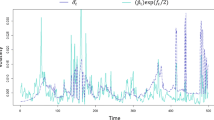Abstract:
We show new modeling aspects of stock return volatility processes, by first representing them through Hammerstein Systems, and by then approximating the observed and transformed dynamics with wavelet-based atomic dictionaries. We thus propose an hybrid statistical methodology for volatility approximation and non-parametric estimation, and aim to use the information embedded in a bank of volatility sources obtained by decomposing the observed signal with multiresolution techniques. Scale dependent information refers both to market activity inherent to different temporally aggregated trading horizons, and to a variable degree of sparsity in representing the signal. A decomposition of the expansion coefficients in least dependent coordinates is then implemented through Independent Component Analysis. Based on the described steps, the features of volatility can be more effectively detected through global and greedy algorithms.
Similar content being viewed by others
Author information
Authors and Affiliations
Additional information
Received 31 December 2001
Rights and permissions
About this article
Cite this article
Capobianco, E. Hammerstein system represention of financial volatility processes. Eur. Phys. J. B 27, 201–211 (2002). https://doi.org/10.1140/epjb/e20020154
Issue Date:
DOI: https://doi.org/10.1140/epjb/e20020154



